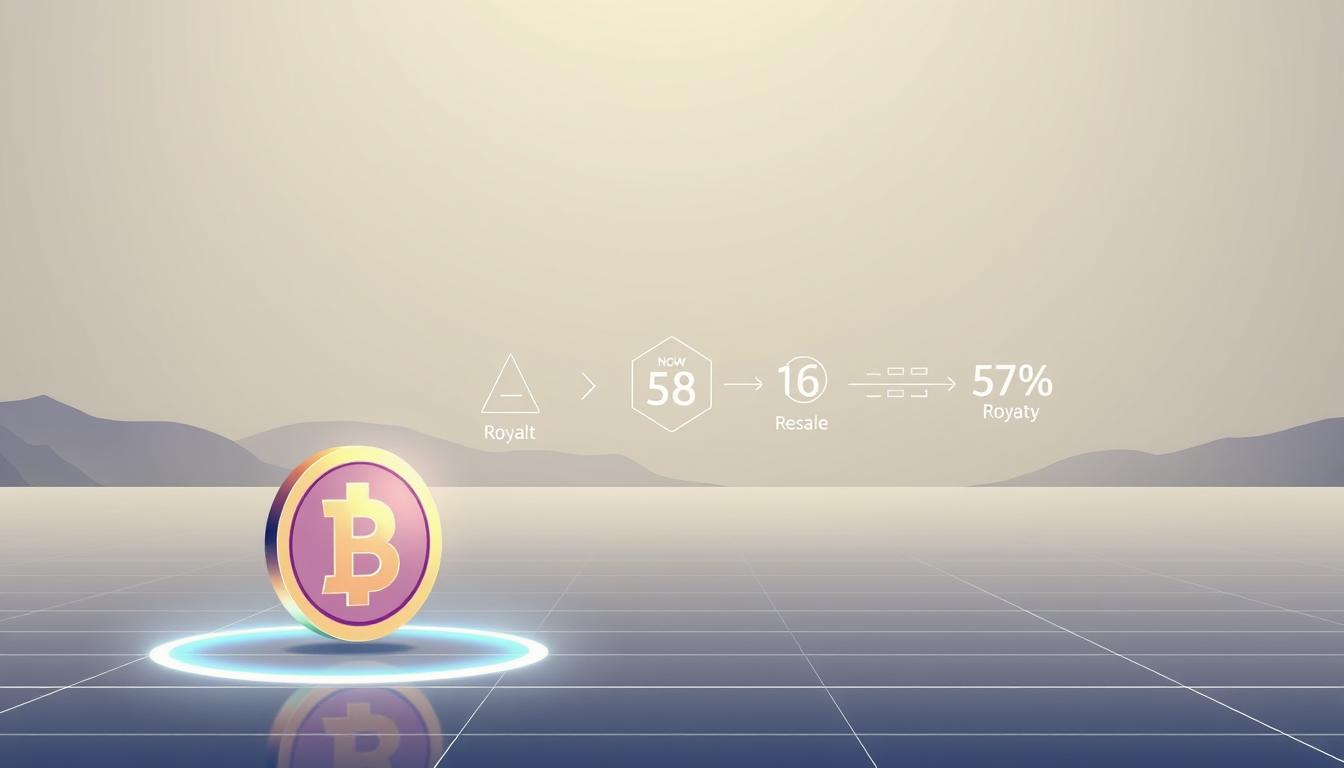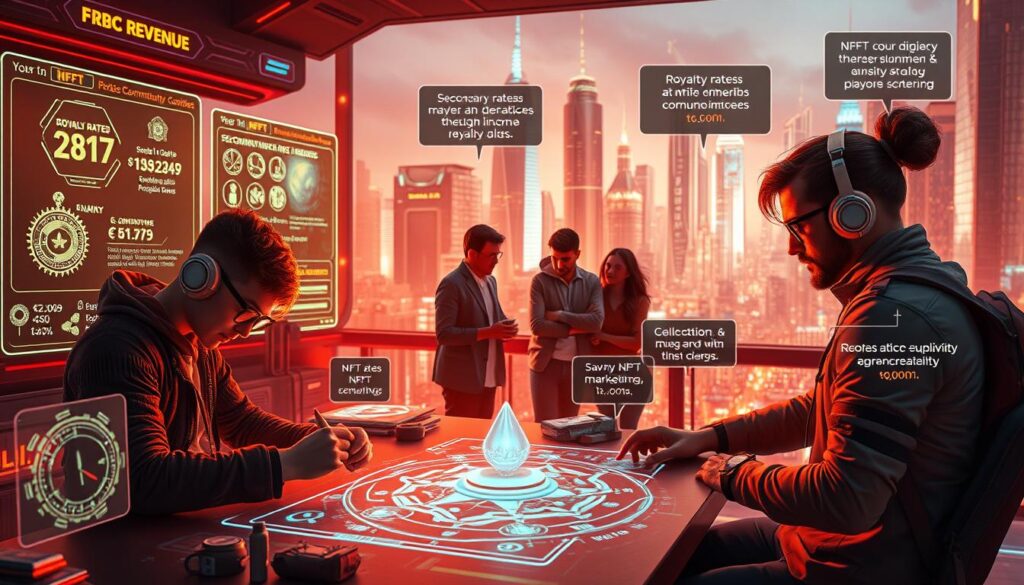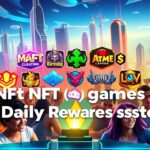Now Reading: How to Earn Royalties from NFT Resales: Tips and Strategies
- 01
How to Earn Royalties from NFT Resales: Tips and Strategies
How to Earn Royalties from NFT Resales: Tips and Strategies

The digital art world has changed forever. For creators, a new era of financial empowerment has arrived. This shift is powered by a revolutionary feature of non-fungible tokens.
Unlike traditional sales, where artists receive a single payment, NFT royalties create a continuous income stream. Each time a digital asset is resold, the original creator gets a percentage. This process is automated and secure.
This system solves a long-standing problem. Famous artists like Robert Rauschenberg saw their works sell for millions later, with no further payment. Blockchain technology fixes this injustice.
The magic happens through smart contracts. These digital agreements execute automatically. They remove the need for middlemen, creating a direct link between creators and collectors.
The market for these digital assets is massive. It reached $80 billion in 2025. Projections show it could hit $231 billion by 2030. This represents a huge revenue opportunity for savvy digital artists.
This guide will explore practical steps for setting up these ongoing royalties. We will cover optimal percentages, platform choices, and strategies to maximize long-term earnings from your NFT creations.
Key Takeaways
- NFT royalties provide creators with automatic payments every time their digital art is resold.
- This system fundamentally differs from traditional art sales, which are one-time transactions.
- Smart contracts on the blockchain enable this automated and transparent process.
- The multi-billion dollar NFT market offers a significant financial opportunity for artists.
- This technology empowers creators by giving them control over their work’s entire financial lifecycle.
- It addresses the historical issue of artists not benefiting from the increased value of their secondary market sales.
Understanding NFT Royalties
Blockchain technology introduces an unprecedented concept for digital creators: automated secondary market compensation. This system fundamentally differs from traditional art sales where artists receive payment only once.
Definition and Importance
NFT royalties represent automated payments that creators receive each time their digital asset resells. This creates ongoing revenue streams unlike traditional one-time transactions.
The importance lies in solving historical inequities. Collectors and resellers traditionally benefited from value appreciation while original creators received nothing from secondary sales.
How Smart Contracts Automate Payments
Smart contracts are self-executing programs stored on the blockchain. They automatically trigger royalty payments when predetermined conditions are met.
During the minting process, creators embed royalty terms directly into the NFT’s code. Yuga Labs’ Bored Ape collection demonstrates this model effectively, generating 2.5% on every resale.
Once programmed into the blockchain, these terms become immutable. This provides long-term income security while maintaining complete transaction transparency.
The Benefits of NFT Royalties for Creators
The advent of NFT technology offers a powerful set of advantages that directly address long-standing challenges for creators. This system fundamentally shifts the financial dynamics in favor of the original artist.
Continuous Revenue Streams
This model generates ongoing income. Unlike a single payment, creators receive a percentage every time their digital asset changes hands.
Some artists earn thousands of dollars monthly from secondary sales. This creates financial stability previously unavailable in the creative industries.
The process is fully automated by smart contracts. Payments are instant and transparent, requiring no effort from the creator.
Empowering Artistic and Digital Innovation
Creators maintain significant control. They set their own royalty percentage, typically between 5% and 10%.
This empowerment incentivizes high-quality, innovative work. When a piece appreciates in value, the artist shares in that success directly.
The system bypasses traditional gatekeepers like galleries and labels. This puts more money and creative freedom directly into the artist‘s pocket.
| Feature | Traditional Model | NFT Model |
|---|---|---|
| Payment Structure | One-time sale, often with a high commission to an intermediary. | Initial sale plus automatic royalties on all future resales. |
| Transparency | Opaque sales data; artists often unaware of secondary market activity. | All transactions are recorded on the public blockchain for anyone to verify. |
| Control | Terms are largely dictated by galleries, labels, or platforms. | Creators set their own terms, including royalty percentages. |
| Earning Potential | Limited to initial sale; no benefit from the asset’s increasing value. | Potential for lifelong revenue as the art gains popularity. |
This financial structure helps combat the “starving artist” stereotype. It allows artists to build sustainable careers from their work over time.
how to earn royalties from NFT resales
The foundation for earning ongoing payments from secondary sales is established at the very beginning of the NFT creation process. Proper setup during minting ensures automated collection of future revenue.

Embedding Royalty Terms in Smart Contracts
During the minting phase, creators embed specific royalty terms directly into the smart contract. This automated system triggers payments automatically on each secondary sale.
The chosen percentage becomes immutable once recorded on the blockchain. Most platforms support royalty rates between 5% and 10%.
Best Practices for NFT Minting
Selecting the right platform is crucial for long-term success. Marketplaces like OpenSea, Rarible, and Foundation offer different approaches to contract creation.
Some platforms allow custom contracts, while others provide standardized templates. Beginners should start with user-friendly options that simplify the process.
| Platform | Royalty Flexibility | Contract Type | Gas Fees |
|---|---|---|---|
| OpenSea | Standard 5-10% range | Template-based | Variable |
| Rarible | Custom percentages | Customizable | Often required |
| Foundation | Fixed 10% standard | Pre-set | Yes |
| Mintable | Full customization | User-built | Gasless options |
For detailed guidance on the initial creation process, explore our comprehensive guide on creating and selling NFTs for beginners. This resource covers everything from asset preparation to final listing.
Key Strategies for Maximizing NFT Revenue
The true financial potential of digital assets unfolds through thoughtful revenue optimization. Successful creators implement strategic approaches that balance immediate income with sustainable earnings.
Optimal Royalty Percentages
Setting the right royalty percentage requires careful balance. Most creators choose rates between 5% and 10% for optimal results.
Higher percentages like Mark Cuban’s 15% can work for established brands. However, excessive rates may discourage secondary market activity.

Leveraging Secondary Sales Opportunities
Building community engagement drives demand for secondary sales. Scarcity and exclusive benefits increase long-term value.
Each resale represents new revenue potential. Strategic pricing and limited editions create momentum in the market.
Using Data-Driven Market Insights
Analyzing comparable projects provides crucial market intelligence. Tracking sales volume trends reveals buyer behavior patterns.
Successful creators monitor price movements and adjust strategies accordingly. For deeper understanding NFT royalty mechanics, explore comprehensive guides.
Navigating the NFT Secondary Market
The secondary market for digital collectibles represents the crucial ecosystem where ongoing creator revenue is generated. This vibrant space functions as the primary engine for royalty payments, where previously purchased assets change hands among collectors and investors.

Understanding this marketplace’s dynamics is essential for maximizing long-term income from digital creations. The frequency and value of resales directly impact the royalty stream creators receive over time.
Trends and Buyer Behavior
Current market trends reveal distinct patterns across different digital asset categories. Art, music, gaming items, and virtual real estate each attract unique buyer demographics with varying preferences.
Collectors typically seek cultural or aesthetic value, while investors focus primarily on financial appreciation potential. This distinction significantly influences purchasing behavior and resale frequency.
| Buyer Type | Primary Motivation | Typical Holding Period | Impact on Royalties |
|---|---|---|---|
| Cultural Collector | Aesthetic appreciation, community status | Long-term (years) | Fewer but higher-value sales |
| Financial Investor | Profit from price appreciation | Short to medium-term | More frequent, smaller transactions |
| Hybrid Participant | Combination of cultural and financial interests | Variable based on market conditions | Balanced sales frequency and value |
Rarity remains a fundamental driver of secondary market value. Unique or limited-edition digital assets typically command premium prices, generating more substantial payments for creators.
Blockchain transparency provides unprecedented visibility into secondary market activity. Creators can track exactly where their assets are, who owns them, and for what price they trade. This real-time data offers valuable insights for strategic decision-making.
Different platforms attract distinct buyer communities with specific trading behaviors. Understanding these marketplace nuances helps creators position their work effectively. For deeper technical insights into this ecosystem, explore this comprehensive guide on NFT royalty mechanisms.
Challenges and Considerations in NFT Royalties
The implementation of automated royalty payments faces practical hurdles across different platforms and jurisdictions. Creators must understand these limitations when planning their income strategy.
Interoperability and Platform Policies
Marketplace policies vary significantly. Some platforms make royalty payments optional for buyers. This can substantially reduce creator income.
Technical workarounds like NFT wrapping allow buyers to circumvent payment mechanisms. These methods alter the digital asset’s code structure.

Strict enforcement requires allowlists that limit trading locations. This trade-off affects NFT functionality and market appeal.
| Challenge Type | Impact on Creators | Current Solutions |
|---|---|---|
| Optional Payments | Reduced and unpredictable income streams | Platform-specific enforcement policies |
| Technical Workarounds | Complete bypass of royalty mechanisms | Advanced smart contract coding |
| Interoperability Issues | Lost functionality across blockchains | Industry standardization efforts |
| Allowlist Limitations | Restricted trading and reduced liquidity | Balanced enforcement approaches |
Legal and Intellectual Property Issues
Jurisdictional differences create significant legal uncertainty. Over 100 countries lack recognition of artist resale rights.
Smart contract agreements exist in a legal gray area in many regions. Enforcement becomes complicated across international borders.
The decentralized nature of blockchain technology complicates dispute resolution. Anonymous transactions make legal recourse challenging when payment terms are ignored.
Leveraging Platforms and Tools for NFT Royalties
Digital platforms serve as the foundation for sustainable creator compensation models. The right marketplace selection directly impacts the effectiveness of automated payment systems.
Popular NFT Marketplaces and Their Benefits
Several leading platforms offer distinct approaches to royalty enforcement. Art Blocks uses smart contracts that guarantee payments on every transaction without exception.
Magic Eden and Yuga Labs are launching an Ethereum-based marketplace with mandatory compensation. This represents a significant industry shift toward creator-friendly policies.
User-friendly options like Mintable eliminate upfront gas fees. They provide accessible tools for establishing preferred royalty rates.
Emerging Technologies and Future Trends
The industry moves toward standardization through technical innovation. Layer 2 solutions and cross-chain bridges maintain functionality across ecosystems.
Decentralized autonomous organizations could provide community-governed enforcement mechanisms. These developments promise more consistent experiences across all platforms.
Collaboration among blockchain networks aims to create interoperability solutions. This ensures creators receive payments regardless of where assets trade.
Conclusion
A new financial paradigm empowers creators through automated compensation. This system fundamentally reshapes artistic careers by providing continuous income from digital artwork. The growing nft market offers substantial opportunity, projected to reach $231 billion by 2030.
Real-world examples demonstrate this transformation. Musical groups like Kings of Leon now receive percentage payments from each secondary transaction. This contrasts sharply with historical cases where artists saw their work resold for millions without compensation.
While platform policies and legal frameworks continue evolving, the core benefits remain clear. Creators maintain unprecedented control over their content‘s long-term value. This technology represents more than additional money—it signifies proper recognition for creative work.
The path forward encourages exploration of creator-friendly marketplaces and community engagement. Understanding these mechanisms enables artists to build sustainable careers while maintaining artistic integrity in the digital age.
FAQ
What exactly are NFT royalties?
NFT royalties are a percentage of the sale price paid to the original creator every time their digital asset is resold on a secondary market. This feature is programmed directly into the NFT’s smart contract, ensuring creators receive ongoing revenue from their work.
How do smart contracts ensure royalty payments?
Smart contracts are self-executing agreements on the blockchain. When an NFT is minted, the creator sets a royalty percentage. This code automatically triggers a payment to the creator’s wallet upon each subsequent sale, making the process trustless and efficient.
What is a typical royalty percentage for NFTs?
While it varies, a common royalty percentage on platforms like OpenSea and Rarible falls between 5% and 10%. The optimal rate balances generating meaningful revenue for the artist while remaining attractive to potential buyers in the secondary market.
Can I earn royalties if my NFT is sold on a different marketplace?
This depends on interoperability. Most major NFT marketplaces honor the royalty terms encoded in the original smart contract. However, some newer platforms may have different policies, which is a key consideration for creators when choosing where to mint their artwork.
Do I need to take legal action to enforce NFT royalties?
Generally, no. The primary enforcement mechanism is the smart contract technology itself. As long as the sale occurs on a platform that supports the contract’s terms, payments are automatic. Legal frameworks around intellectual property rights for digital content are still evolving.
What are the main benefits for artists using NFT royalties?
The biggest benefit is a continuous revenue stream. Unlike traditional art sales where artists only profit from the initial sale, NFT royalties provide ongoing financial rewards as the value of their digital art or music increases in the secondary market, empowering long-term creative careers.












